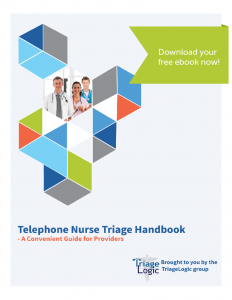The primary goal of the telephone triage process is to deliver safe quality oriented telephone triage partnered with outstanding customer service. The health safety and wellbeing of the patient is at the forefront of every telephone encounter. The purpose of the telephone triage process is to assess the patient’s current signs and symptoms, concurrently evaluating their past medical history and current medications. This patient assessment is performed in accordance with protocols which guide the nurse to determine the proper triage disposition to direct care to the safest, most cost-effective medical facility available at that specific time.
To accomplish the goals of the telephone triage process an organization needs to recruit, hire, train and retain experienced telephone triage nurses. Two valued components that will result in quality patient outcomes are providing comprehensive, detailed orientation, as well as equipping the nursing staff with the tools of the trade, gold standard telephone triage protocols. However, the final determining factor of quality phone triage lies in the training of nurses to utilize the protocol tool properly. After all, anyone can read a protocol. It is the knowledgeable triage nurse that applies the following attributes of enhanced assessment skills, superior judgment, prior nursing experience and exceptional decision-making abilities to the protocol tool that results in safe, quality outcomes and cost-effective patient care.
Performing hands-on patient assessment allows the health care provider to visualize cyanosis, smell foul drainage, palpate an abdomen, and use a stethoscope to assess patients’ lung sounds. The telephone triage nurse does not have such luxuries to assess her patient’s needs, as she/he is limited to their ability to quarry and listen intently to the caller to obtain the necessary details of the patient’s medical symptoms and direct medical care accordingly.
Successful triage nurses live by the following “Golden Rules” of the Telephone Triage Process:
· Every call is life threatening until proven otherwise
· ABCD assessment must be completed with every telephone encounter: Airway, Breathing, Circulation, Deficit (Neuro).
· Assessing patients over the phone is high risk; therefore take the callers word as gospel truth
· Follow your 6th sense: Protocols are decision support tools nursing judgment determines outcomes
· Know your patients’ medical history and current medications
· Assess your callers as well as your patients – Be a patient advocate
· Never provide a dosage of a medication without a complete patient assessment.
· Always confirm labeled dosage of a medication as well s the means in which the caretaker plans to administer the drug.
· Always assess the caller’s level of comfort with the established plan of care before ending the call.
o “Are you comfortable with these recommendations”
o “Now tell me what you plan to do next”
· If it is not documented… it didn’t happen. Use defensive documentation. Paint a picture.
· Regardless the reason for the call – always obtain a rectal temperature on an infant under the age of 3 months.
· Document the exact mechanism of injury
· Be alert for Red Flags: Any time a caller uses or implies one of the following phrase(s) be sure to clarify the underlying meaning. Carefully analyze your disposition & recommendation for follow-up care:
o Grunting /Moaning
o Lethargic / listless
o Sleeping more than usual
o Just doesn’t look right or act right / fussy
o Sleeps thru a rectal temperature
o High pitched cry or unusual /funny cry
o History of sickle cell or immune deficiency
o Frequent callers
o Caller that expresses anxiousness or numerous questions after plan of care has been discussed
o Patient symptoms of headache, dizziness, disorientation, nausea, fatigue/irritability – flu vs. Co2 exposure.
· At the conclusion of the patient telephone encounter instruct callers to call back or seek medical evaluation if current symptoms become worse or additional signs and symptoms of concern develop.
· Triage Nurses don’t always have to be right; we just can’t afford to be wrong. Always err on the side of caution!
Learn more about telephone nurse triage and how to implement successful triage nurse centers by downloading our free eBook: Telephone Nurse Triage Handbook





